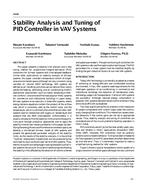Description
This paper presents a stability limit analysis and a new tuning method for proportional-integral-derivative (PID) controllers for bilinear systems with time-delayed feedback. Unlike other publications on stability analysis of bilinear systems, this paper considers temperature control of single-zone environmental space (although not very common) using variable air volume (VAV) technology. VAV systems are defined as air-handling units that use variable airflow rate to satisfy the heating, ventilating, and air-conditioning (HVAC) operational requirement–such as indoor temperature (thermal comfort)–and are one of the most popular HVAC systems for commercial and institutional buildings in Japan today. Bilinear systems arise naturally in these VAV systems, where energy balance equations contain the product of the airflow rate, which is commonly used as the control input, and the temperature, which is commonly the controlled variable. VAV systems lead to instabilities with supply air temperature and pressure that are often unacceptable. Unfortunately, it is usually not easy to find the stability limits around the equilib-rium point through analytical approaches and to apply the stability limits to real industry problems. In this paper, by identifying the energy flow to and from the environmental space, we develop a normalized bilinear model of VAV systems and present the generalized parameter analysis of the stability limits. As the results of the stability analysis, it is found that “hunting” phenomena (instabilities) are not produced by the nonlinearity (such as the bilinear term) of VAV systems. Thus, there is no significant advantage in taking the stability of bilinear systems into account. Simulation results are given showing the stability limits affected by the selection of control schemes and system parameters. The optimum tuning of controllers for VAV systems is derived from optimization techniques. The PID parameters for a linear system must be modified slightly by finding the gain reduction factors to suit real VAV systems.
Units: SI
Citation: ASHRAE Transactions, vol. 107, pt. 1
Product Details
- Published:
- 2001
- Number of Pages:
- 12
- File Size:
- 1 file , 310 KB
- Product Code(s):
- D-7139




